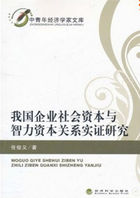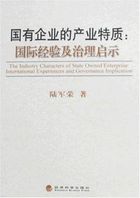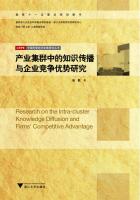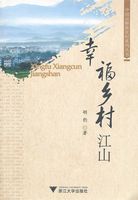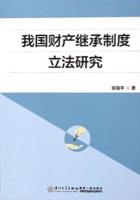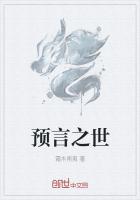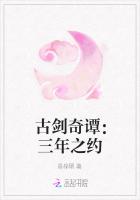2007 CHINA’S 2007 CHINA’S INDUSTRIAL DEVELOPMENT REPORT——The Status quo and Analysis of China’s Industrial Development Performance
Chapter 1
Overall Analysis of Industrial Economy Performance
During the 10th Five-year Plan period,China has sustained rapid industrial development;industrial economy performance improved significantly,industrial profits and personnel labor productivity doubled。Due to the rapid expansion of investment in fixed assets and the rising proportion of the heavy and chemical industry,contradiction between supply and demand of fundamental-industries products such as energy and raw materials,increased sharply。Factor cost on resource product prices,labor wages and capital increases year by year。Due to price inflation and production expansion,sales and profits of coal,oil and gas,steel and chemicals industries contribute to over 50%of the total industrial profits。Profits of final goods such as electronic communications products and transportation equipment manufacturing,fell significantly as a result of price inflation of upstream products and sales price deflation of products。Through strategic restructuring,the number of state-owned and state-holding enterprises reduced significantly,with scope of business to focus on fundamental-industries and constantly expanding in scale,they achieved significant profit growth,reversing the status that economic benefits of state-owned and state-owned industrial enterprises was lower than that of private enterprises and foreign-funded enterprises(i。e。contractual joint ventures;
cooperative ventures and solely foreign-funded enterprises)。Total energy consumption grew rapidly and simultaneously with industries during the 10th Five-year Plan period,calculated by comparable price,energy consumption of every 100 million CNY industrial added value,merely dropped by 1.34%。The low efficiency of energy use is a result of no effective adjustment of industrial structure and low efficiency of energy use of SMEs(small and medium-sized enterprises)in resource-intensive industries,in the process of rapid growth of total energy consumption。During the 10th Five-year Plan period,the environmental control has achieved remarkable success,the downward trend of main pollutant emission intensity was continuing,but to achieve the 11th Five-year Plan’s targets of conserving energy and reducing emissions,we are still faced with arduous tasks。
Chapter 2
International Competitiveness of China’s Manufacturing Industry
Since the reform and opening up,the international status of China’s industries reflected by export growth rate and exports continued to improve。In particular,the performance of China’s manufacturing industry is prominent in international trade and now China has become an important trade surplus of the world,reflecting China’s industrial products with strong international competitiveness。Analysis indicates that the comparative advantage and competitive advantages of China’s manufacturing industry are upgrading,in which is a major factor the increase of competitive advantage。China currently is undergoing an upgrade of the industrial structure,competitive industries is transforming from the traditional labor-intensive industries to capital-intensive and technology-intensive industries。And that industrialization in China is entering a new stage of heavy and chemical industrialization,whether the heavy and chemical industry could further enhance international competitiveness will determine the basic development trend of international competitiveness of China’s industries。In this stage of development,
the upgrading of international competitiveness of China’s industries is faced with severe challenges of resources and environmental。Only when China’s industries and enterprises no longer rely mainly on the large inputs of low-cost resources and the neglect of environmental protection to achieve the low price products advantage,and is able to maintain and continually enhance its international competitiveness,can China prove that its industry international competitiveness is of inherent nature and sustainable。Therefore,it is China’s core strategic task of the new stage of industrial development to maintain and further enhance the international competitiveness of China’s industries with higher standards on resource conservation and environmental protection。
Chapter 3
Comparison of Regional Industrial Development Performance
This chapter has given a complete comparative and systematic analysis about the economic performance,social benefits and ecological environment benefits of industries in East,Northeast,Central and West China,and 31 provinces and cities in China since the 10th five-year plan from 2 different layers。The analysis shows that,in recent years the industrial performance has been generally improved in China,but there still exists great regional difference。Even the index of industrial economy performance is not as simplified as what people usually think:“the eastern is higher while the western is lower。”For example,the ratio of industrial added value and overall capital output ratio in East China is the lowest among the four regions in China,cost margin and personnel labor productivity is lower than that in Northeast and West China。From social benefits of the industries,the average wage increases of industrial workers in eastern China is of in the nation’s slowest,industrial growth mainly depends on the support of labor-intensive industries,the proportion of R&D staff to all employees of large and medium-sized enterprises is of the lowest in the four regions。More importantly,there is still problems in China’s industrial development such as high consumption of energy and resources,large emissions of“three wastes”,
extensive economy growth mode,low technology level of products,the ability of self-innovation is not strong,serious disharmony among economic performance and social benefits and environmental benefits。Therefore,we must follow the concept of scientific development,strengthen industrial resource conservation and environmental protection,to develop the recycling economy,and continuously improve the ability of self-innovation,and promote the comprehensive improvement of industrial performance。Firstly,to control the overall situation with the concept of scientific development,to firmly establish the review of comprehensive benefits including economic performance,social benefits and environmental benefits;
secondly,to guide the regions’positioning in accordance with its main function,constant optimization of the regions’industrial structure,develop industry chain of leading edge,and develop characteristic economy vigorously in order to facilitate the regions’economy gradually shifting to the way of characteristics,specialization,intensive and advancement;thirdly,we must foster a scientific view of achievements,establish a scientific government evaluation index system;fourthly,to explore and establish a scientific evaluation index system,to give a comprehensive evaluation of social benefits in the industrial investment projects and industrial development;fifthly,highly emphasized ecological and environmental benefits,and actively promote the eco-industrialization of the regions,so that the development of recycling economy and environment-friendly economy will become a bottom-up conscious action,a pattern of growth,a social responsibility and a built-in mechanism。
Chapter 4
Performance of Industrial Organization
China’s industrialization access S to a new phase of rapid growth of the heavy and chemical industry,the total economy output and industrial scale keep steady and rapid expansion year after year。To a certain extent,industrial growth relies on the resources support,the large and fast-growing consumption of resources and raw materials,the problem of industrial organization unreasonable and the non-economic scale of production plant has become increasingly prominent。Corresponding to the above mentioned issues,the State formulated industrial organizing policies of improvement of the market access as the core。To eliminate backward production capability,optimize order in competition,to strengthen coherence between the industrial organizing policy and the financial policy,fiscal policy,technology policy and trade policy,a new pattern of industry organization began to emerge,
benefits of industry organization improve to a certain degree。This chapter,with the use of statistical data of all state-owned and large non-state-owned enterprises,analyzes China’s industrial organization and the changes and trends of China’s industrial organization and industrial benefits through changes in the indicators of scale and benefits of the scale enterprises,large and medium-sized enterprises,state-owned and state-holding enterprises。In order to speed up the overall change of the problems including low technical level of China’s industrial organization,unreasonable labor division,serious constraints of resources and environmental,we must deal with the relations between the government and the market,the central and local,and optimize the systematic conditions of resources and environment use,strengthen and improve the industry-incentive-oriented organizing policies,focus on cultivating competitive large enterprises and enterprises groups,and actively guide SMEs into the development system of large enterprises and large conglomerates,to promote the development of new professional collaboration system of labor division among large,medium and small enterprises。
Chapter 5
Performance Analysis of Industrial Fixed Assets Investment
The performance of industrial fixed assets investments can be analyzed from two aspects。One is the stimulating of the investment itself to the economy;the other is the effect of the investment throughput on industrial economy and resources environment。Since the 10th Five-year Plan,according to the investment increasing and the index of investment’s effects of the whole society and fixed assets,the tendency of fixed assets efficiency and benefits decreases,and at the same time has bad effects on excess-capacity and ecologic environment。But according to the index of microeconomic performance,China’s industrial enterprises face increasing demands of the market。Not only does the tendency of industrial investment’s return increase obviously,but also the return exceeds Japan in the corresponding period。Indeed,the rate of private enterprises’net profits before tax is close to that of the manufacturing industries of USA。
The concurrent complexion of low efficiency in macro economy and the high performance in micro economy can explain the great divarication about the understanding of excess-capacity among the state decision-department,local government and enterprise in a certain extent。The report said that,under the environmental conditions of lack of property rights clarity in the existing factor market and distort of pricing mechanisms,the high-margin of enterprises investment to some extent,is based on loot of factor price and social wealth transfer,enterprises’private cost can not reflect the actual social cost。Therefore,it is a very necessary for the government to focus on the social control of enterprises production and operation,adjust and improve the basic pattern of industrial investment in terms of the concept of scientific development,forcing the community to bear its responsibilities by controlling unreasonably high-profit margins of the capital。
Chapter 6
The Labor Efficiency
Entering the 21st century,China’s industrial enterprises labor productivity has sustained rapid growth;labor efficiency has been greatly enhanced providing the impetus to a sustained industrial development。From the whole industries,labor productivity growth should be mainly attributed to the increase of various industries’labor productivity and the growth effect contributed by the changes of factors in the employment structure is small。This shows that it has achieved important results for the Chinese industrial enterprises to significantly increase labor productivity by increasing the level of automation,reducing labor inputs,improving workforce quality and improving the management。However,compared to that of the major developed countries,China’s industrial enterprises labor productivity level is still very backward,and not even comparable to some medium-developed countries。China’s industrial enterprises still need to raise the level of labor productivity。In order to improve labor productivity of industrial enterprises,for one thing,we need to raise the added value of products;on the other hand,we should rapidly and comprehensively enhance the quality of labor so that human resources will play a greater role in the production of added value。
Chapter 7
Benefits of Resources Utilization and Environmental Management
Over the past 30 years,China’s industrial has developed very quickly and has become one of the world’s major energy consumption countries,consumption of partial resources are among the highest in the world,import dependence increased,although the ecological environment in some areas has improved,but the overall trend continues to deteriorate,as a result environmental and resources constraints in the face of China’s industrial development have become increasingly serious。It is an urgent need to solve the major problem in China’s economic and social development process to effectively ease the resource and environmental constraints on industrial development,improve resource utilization efficiency and strengthen environmental management。The relationship between China’s industrial development and resources as well as environment has not yet entered a virtuous circle。During the 10th Five-Year Plan period,the energy intensity rises,
intensity of mineral resources consumption and the emission of pollutants rebounded,water consumption is of a declining trend,resource utilization efficiency of some industries rose significantly,but compared with the advanced international level,there are still large gaps。China’s low efficiency of resources utilization are caused by many reasons,including the heavy and chemical industrialization of the economic structure,slow technological progress;irrational Industrial Organization structure,small-scale of enterprises;the low level of comprehensive resources utilization,and the serious soft constraints in environmental control。Therefore,in order to improve the utilization efficiency of resources and the environment,in the future,China must make efforts to improve its economic structure and optimize the industrial organization approach,and to increase rate of recycling and reuse,vigorously promote the development of recycling economy and eliminate backward production capacity,promote the appropriate scale of the enterprise,strength on environmental control and constraints。
Chapter 8
Efficiency of Energy Utilization
This chapter analyzes and calculates China’s energy use efficiency and changes in trends with the constant price。What’s more,the reasons for the decline of energy utilization efficiency were analyzed from aspects such as supplies and consumption,the industrial structure and industrial energy utilization efficiency,direct and indirect import and export of energy as well as system and policy。The results show that,in recent years,China’s energy supply efficiency has declined,while consumption efficiency has increased。The structure factor has a negative influence on the energy utilization efficiency and the proportion of industrial and industrial energy utilization efficiency have a decisive impact to improve energy utilization efficiency in China。Exports of high-energy consuming products and the low-grade
division of international industries are not conducive to China’s energy utilization efficiency improvements。The weakening of the energy-saving policies and the management system which once appeared is also one of the reasons that the energy efficiency improvement did not continuously go further。This chapter compares the internationa energy utilization efficiencies,and concludes that China’s energy utilization efficiency has great gap to the other countries,but there is no doubt that China is the biggest country of energy utilization efficiency improvement in the world。The gap is gradually narrowing between China’s energy utilization efficiency and that of the advanced international level。Finally,from the aspects of accelerating technological innovation,maintaining modest economic growth,optimizing the industrial structure,improving energy prices mechanism and others,this chapter proposes policies and recommends to the improvement of China’s energy utilization efficiency。
Chapter 9
Industrial Logistics Performance
With competition in the market gradually matured,obvious changes have taken place in the logistics concept,the logistics technology,the logistics measures and the logistics implementation modalities of Chinese enterprises。Development and innovation of operation mode of enterprises logistics and management concept is a driven force for the improvement of logistics efficiency。Since the 10th Five-Year Plan period,the logistics speed of industrial raw materials and products gradually accelerates;the proportion of logistics costs account for sales keeps declining。The rapid development of modern logistics mainly TPL is effectively promoting the transformation of industrial growth mode and growth efficiency。The industrial logistics is a subsystem in industrial economic operation,the efficiency of which is determined in-depth by the professional level and social level of industrial production。Compared with developed countries,there are still gaps and shortcomings in many aspects of China’s industrial logistics。To further improve the economic performance of the industrial logistics,the main task is to vigorously develop modern logistics system,actively promote logistics outsourcing of industrial enterprises,to comprehensively strengthen logistics management of enterprises and accelerate logistics personnel training。
Chapter 10
Performance of Energy Industry
Since the 10th Five-Year Plan period,China’s energy industry has sustained a rapid development,industrial-scale keeps growing,industry profits grows sharply,and pollutants emission is under control,production safety situation also has been further improved。Energy industry’s profit rises for the effects of external factors such as energy industry reform and price inflation,as well as the role of the overall improvement of industry production and operating efficiency。From a global perspective,China’s energy production scale is in the forefront of the world,but there is still substantial gap with the developed countries in aspects such as profit levels and profitability,production efficiency and pollutants emission。Subject to resource conditions and environmental conditions,the development of China’s energy industry is still facing great pressure。We believe that the energy industry should not set profit growth as the main goal,but should set ensure energy security and energy saving and emission-reduction as a priority。In order to promote the fast and sound development of the energy industry,we need to deepen the reform of the energy management system continuously,promote energy saving and emission-reduction of the energy industry,and strengthen energy security development。
Chapter 11
Performance of Steel Industry
In recent years,driven by the strong growth of market demand,the improvement of technical equipment level,process optimization and the increased ability of independent innovation,China’s steel industry stopped the sluggish of market demand and the continued downturn in the development in the late 1990s,the growth rate was significantly accelerated,the economic benefits significantly improved,the ecological and social benefits have also made notable improvements。However,compared with the advanced international level,China’s steel industry has a relatively low level of economic performance,there is still substantial gaps in consumption level of energy and material as well as the capacity for sustainable development。Looking to the future,resources and the environment faced by the development of China’s steel industry will be increasingly constrained,the driving role of market
demand may be gradually weakened,and the international trade environment may also tend to deteriorate。Facing the various above mentioned risks and challenges,in order to continue the current performance status,the steel industry is expected to increase investment in research and development,and speed up the development of independent innovation ability,improve the technical level of industry and promote industrial upgrading。To improve and optimize the industrial structure,conform to the social demands for sustainable development,develop cycling economic,reduce material and energy consumption,attached importance to environmental protection and improve comprehensive competitiveness of the industry,and actively explore possible strategic reserves of iron ore,control supply risk and price risk of raw materials in particular iron ore。
Chapter 12
Performance of Petroleum and Chemical Industry
Entering the 21st century,China’s petroleum and chemical industry has entered a new period of fast and sound development。Various economic indicators have sustained faster growth。In particular after the central government put forward the concept of scientific development to guide future work as a whole,it has been consensus and Program of Action to the development of petroleum and chemical industry,to adhere to the road of sustainable development,coordinate and persist in economic performance,social benefits and environmental benefits。Over the six years,the petroleum and chemical industry products output has sustained a more than doubled growth and industry-wide product sales revenue growth is of 2.23 times,2.43 times of the profit growth,excluding price inflation factors,the actual growth is about two times,and economic performance improved significantly。The industrial structure of petroleum and chemical industry is increasingly rational,obvious achievements has been made in technological progress,technology development and new product rate is further enhanced。At the same time,we must realize that there are still many aspects in the petroleum and chemical industry in need of improvement such as energy saving,pollutants emissions and safety production。
Chapter 13
Performance of Building Materials Industry
Since 2000,driven by the domestic and foreign economic growth and demand,China’s building materials industry sustained a rapid economic growth and has shown numerous new features。Facing the pressure of environment,resources and costs rising,the building materials industry changed the pursuit of unilateral extensive growth mode in pursuit of scale and quantity,it is an important and pressing issue to realize the growth-led development model of quality and efficiency in the economy sustained development。Therefore,this article has chosen a series of indicators,and inspected the quality of growth from 2000 to 2006 in China’s building materials industry focus on the following four aspects resources conversion efficiency,operating efficiency,trade competitiveness and social benefits。Research revealed that industry personnel labor productivity,ratio of added value,cost margin and the contribution rate of assets basically showed a different degree
of increase in the period;industry energy consumption intensity and rate of assets and liabilities declined;the total competitiveness index of building materials industry trade continuously improved,but mining products competitiveness of non-metallic minerals trade show a downward trend;prices of building materials industry product in the export trade has increased,but well below the imports prices of similar products;emissions and comprehensive utilization of waste in building materials industry has been increasing。Comprehensive analysis shows that from 2000 to 2006,the quality of economic growth of China’s building materials industry gradually improved and economic benefits achieved significantly improvement。Furthermore,based on international comparison and analysis of the building materials industry efficiency indicators,this chapter proposed recommendations and relevant policy on the problems and gaps of China’s building materials industry。
Chapter 14
Performance of Equipment Manufacturing Industry
In recent years,as one of leading industries with a significant impact on the national economy development,the equipment manufacturing industry has maintained a rapid growth。With the rapid growth of output,the economic performance of the equipment manufacturing industry is also constantly upgrading。From 2000 to 2006,total profits of the equipment manufacturing industry grew by an average of 26.1%;capital profit margins and income profit margins both have different levels of increase。Analysis showed that during this period economic performance improvement of the equipment manufacturing industry is based on the improved economy efficiency and is the result of the common factors of economies scale and technological progress。On the other hand,the facts that there is a significant discrepancy between China’s economic efficiency of the equipment manufacturing industry and that of the advanced international level,
shows that the economic performance of the equipment manufacturing industry still has a relatively large room for improvement。In view of the main problems facing,major channels to further improve the economic performance of China’s equipment manufacturing industry includes:to create a good environment needed for development of the equipment manufacturing industry;a number of major infrastructure projects with the national support and Unity Organization as driven force to the overall improvement of infrastructure technological level of equipment manufacturing industry;to further improve incentives and policies to encourage investment increase in research and development of the equipment manufacturing enterprises;development of a professional collaboration matching system;foster a number of large equipment manufacturing groups with capacity of design and complete sets。
Chapter 15
Performance Analysis of Automobile Industry
In 2006,China’s automobile industry sustained another growth peak after accession to the WTO。China has surpassed Germany,is the world’s third largest auto-producing country after the United States and Japan。China has become No。2 of the world’s car sales market。While with the rapid expansion of the scale of China’s automobile industry,China’s automobile industry is also facing a number of outstanding issues:declining margins while expansion of the scale;faced with the increasingly serious energy and resources constraints;the growing pressure from the environmental protection;with excess capacity increasingly conspicuous,the industry has been listed as a key adjustment industry by the central government;the rapid expansion of exports while exports disorder,and the poor benefits of exports;the still insufficient ability of independent innovation is the main bottleneck for development of the automobile industry。
Since joining the WTO,the automobile industry of China has sustained the rapid development;the scale expanding is not the issue。To turn the scale expanding to the improvement of level and achievement of fast and sound development have become the main issues to resolve for a further development of the Chinese automobile industry。Therefore,the government needs to guide the automobile industry through financial taxation and technical standards,into energy saving,resources and environment-friendly industry。Automobile industry enterprises should also make efforts in aspects such as research and development,marketing services,finance,logistics,and enhance the all-round level of operation and profitability。
Chapter 16
Performance of Electronic Information industry
China’s electronic information industry sustained rapid growth in recent years and take a more salient position in the national economy;production and sales of the main products is in the forefront of the world;foreign-funded enterprises have become an important force in industrial development;the core infrastructure industries has been gaining more and more attention and development speeded。But the economic performance of China’s electronic information industry can not be optimistic,within the major economic indicators,only labor productivity is significantly higher than that of the industries’average,while ratio the industrial added value,and the contribution rate of total assets and the cost margins are below that of the national average。In the main industries,communications equipment manufacturing industry and the software industry get relatively good economic returns,computer and TV industries sustain lower profits,and performance of integrated circuit chip manufacturing began to improve。The main economic factors affects the performance of China’s electronic information industry are:
the lack of core technologies,serious product homogeneity,three-funded enterprises transferring profits and China’s export tax rebate policy changes after accession to the WTO and setup of foreign trade barriers。From social benefits,the electronic information industry development contributes to the increasing popularity of electronic products;continuous improvement of information infrastructure,improvement of information-based national economy。At the same time,manufacturing process of electronic information products and electronic garbage has a negative impact on the ecological environment。Judging from the development trend,spending in the core technology will improve China’s electronic information industry economic performance in the future,vigorously development of the software industry is conducive not only to readjustment of the industrial structure,employment promotion,but also conforms to the requirements of sustainable development。China’s e-waste management has been integrated into the legal track。
Chapter 17
Performance of Textile Industry
After the restructuring at end of the 20th century,technological progress of the textile industry in recent years accelerates,the scale of production and exports continued to expand,the quality of economic operation improved,overall performance of the industry has improved。With marketing of industry and the speeding up of opening up process,the main competitors in the textile industry increased and competition has become increasingly fierce,squeezing the profit margins of the industry。Coupled with the implementation of factors such as national macro-control policy,production costs rose,the downward of export tax rebate,RMB revaluation and increased international trade friction,difficulty to further improve the economic performance of the textile industry increased。From social benefits,the textile industry as one of China’s traditional labor-intensive industries has played a positive role in meeting consumer demand,
creating jobs and promoting urbanization。Social responsibility system development of textile enterprises have made some progress,but for environmental impact,the water consumption and energy consumption of textile industry remain high,the environmental pollution problems are prominent。Faced with the new situation of the economic and social development and changes in the international environment,textile industry,in the future development,should cover the social performance,economic benefits and environmental benefits,based on technical innovation and structural adjustment,vigorously develop recycling economy,change the mode of growth,promote the sound and fast development of the textile industry to upgrade the overall ability of independent innovation and international competitiveness of textile industry,accelerate the achievement of the changes from“textile big country”to“textile powerful country”。
Chapter 18
Performance of Home Appliance Industry
China’s home appliance industry is one of the earliest opening industries to the world market。After two or three decades of development,China’s home electrical appliance industries completed the assembly from consumer and white electronics to small appliances,from raw materials and spare parts to whole products assembly,and formed the Central Industrial Cluster Strip of Pearl River Delta,Yangtze River Delta and Bohai Bay region;nurturing a number of domestic appliances brands of a certain market and competitiveness;china has become the world’s electronics manufacturing center。The development of electronics industry provide consumers in China and other countries with a large number of low-cost,
feature-rich products,played a positive promoting role to enhance the living standards of residents and provided the community with a considerable job opportunities。However,due to lack of core technologies of major home appliances,China’s home appliance industry is still in the development model of scale-driven,although some leading enterprises already have a certain independent capability of R&D and technological innovation,but the industry has not yet entered the stage of technical innovation-driven development。In an increasingly competitive environment,the economic performance of the home appliances industry keeps downturn。Under constraints of energy,resources and environment,China’s home appliance enterprises can only really achieve economic performance,social benefits and ecological benefits simultaneously by means of improve the ability of independent innovation fundamentally,realize changes from the scale-driven model to innovation-driven in the home appliance industry development。
Chapter 19
Performance of State-owned Industrial Enterprises
During the 10th Five-Year Plan period,state-owned and state-holding industrial enterprises are constantly expanding in scale as a whole,performance improved,efficiency continued substantial growth,the efficiency has been raised relatively,the level of economic performance knocked to a record high。Situation breakthroughs and achievements in this period are closely linked to a series of measures on the development and reform of state-owned enterprises,including basically achieving the three-year goal of poverty eliminating,separating of chief and secondary business and secondary business restructuring,strengthening of state-owned assets supervision,and the strategic readjustment of the state-owned economy,especially the focus on reform on enterprise system played a role in the reform of property rights。However,the scale of change and efficiency improvement does not mean that the state-owned and state-holding industrial enterprises began to improve operational efficiency。Analysis shows that the structure and capacity of state-owned and state-holding industrial enterprises are continuously focused on six industries of petroleum and gas exploration,the improvement of performance indicators rely mainly on six major industries state-owned enterprises of a monopoly and quasi-monopoly position。State-owned enterprises reform has achieved some initial results;yet there is a long way to go to continuously deepen the reform。
Chapter 20
Economic Performance of Listed Companies
In the context of China’s macro economy in a sustained,rapid and steady growth,listed companies are undergoing a sound development。From the four aspects of total net profit,profitability,asset quality and financial risk of listed companies,since 2000,the total net profits of listed companies sustained growth,level of profitability is higher,and mean time the quality of assets and asset utilization of listed companies is rising steadily。What is noteworthy is that while the listed companies have expanded and the level of profitability improved,the company’s financial risk also has maintained a level of stability and has been under control in the acceptable range。Looking at the situation of different industries,since 2000,the listed companies of mining,metals,non-metallic,electricity,steam and water production and supply,transpor-tation and warehousing industries are of better economic situation,listed companies of the electronics industry is of worse economic performance。Macro economy,market system and the consumer will have an impact on economic performance of listed companies。For future conditions of economic performance of listed companies,macroeconomic stability growth will provide a solid economic upgrade protection to listed companies,consumer upgrades will play a driving role in enhancing the economic performance of listed companies,system innovation factors will further deepen the economic performance of listed companies。
Chapter 21
Performance of Three-funded Enterprises
Three-funded enterprises hold an important position in China’s national economic and social development。Based on the eight indicators including losses,loss rate,the contribution rate of total assets,the rate of assets and liabilities,cost margin,industry ratio,personnel labor productivity and liquidity of working frequency from 2000 to 2006,this chapter inspected the economic performance of three-funded enterprises and investigated the social benefits of three-funded enterprises in five aspects such as the expansion of employment effects,the effect of income growth and the effect of taxation growth,effects of trade increasing and technological innovation and together with a brief analysis of the ecological benefits of the three-funded enterprises。In order to improve comprehensive performance of the three-funded enterprises in the future period,the following proposals are given:firstly,to pay greater attention to structural optimization;secondly,to pay more attention to the processing trade;thirdly,it is necessary to pay greater attention to the decline of performance;fourthly,we should pay greater attention to issues of social responsibility;fifthly,to pay more attention to energy consumption and eliminate emissions;sixthly,more focused on economic security issues。
Chapter 22
Performance of the Private Industrial Enterprises
From 2001 to 2005,private industrial enterprises have made rapid development;economic performance,social benefits and asset size obtained double-growth。Status and role of private industrial enterprises in the industrial economy are rapidly upgrading。From the scale of assets,assets of private industrial enterprises in 2001 is only 6.7%comparing to that of state-owned and state-holding industrial enterprises,but reached 27%in 2005 comparing to that of state-owned and state holding industrial enterprises。From profit realization,profits of private industrial enterprises in 2001 is only 21%comparing to that of three-funded industrial enterprises,while in 2005,it has been reached 51%comparing to that of three-funded industrial enterprises。From the taxes payment to the state,taxation of the private industrial enterprises in 2001 is only 8%comparing to that of state-owned and state-holding industrial enterprises,while in 2005 is 27%comparing to that of the state-owned and state-holding industrial enterprises。From the creation of employment opportunities,employment opportunities of the private industrial enterprises in 2001 is only 20%comparing to that of the state-owned and state-holding industrial enterprises,while in 2005 reached 90%comparing to that of state-owned and state-holding industrial enterprises。We can see that,relatively speaking,China’s private industrial enterprises,which occupy fewer assets,and create more efficiency,grow faster in taxes payment and rapidly create a large number of job opportunities,are growing soundly。

